Commuting by bike is a popular option for people who want to avoid public transport or enjoy the exercise and pleasure that cycle commuting can bring.
But if you’re planning to use your bike to ride to work, you’ll probably need to carry more gear than you’d want for a short ride at the weekend. Who wants to spend the day at work in sweaty kit they’ve been riding in, or worse still damp clothes from a wet commute?
Plus, you may have documents or a computer that you need to carry to and fro. Add to that cycling-specific equipment such as a lock, and the essentials you may need in the event of a roadside mechanical – pump, spare inner tube, tyre levers and a multi-tool – and you may find that you’re lugging quite a lot of stuff on your ride.
So what solutions are there to carry all you need to and from work in comfort? You’ve got six main options: your pockets (for the bare essentials), a backpack, a messenger bag, bikepacking bags, a basket, and panniers.
Let’s run through each to find the best option for you.
Pockets
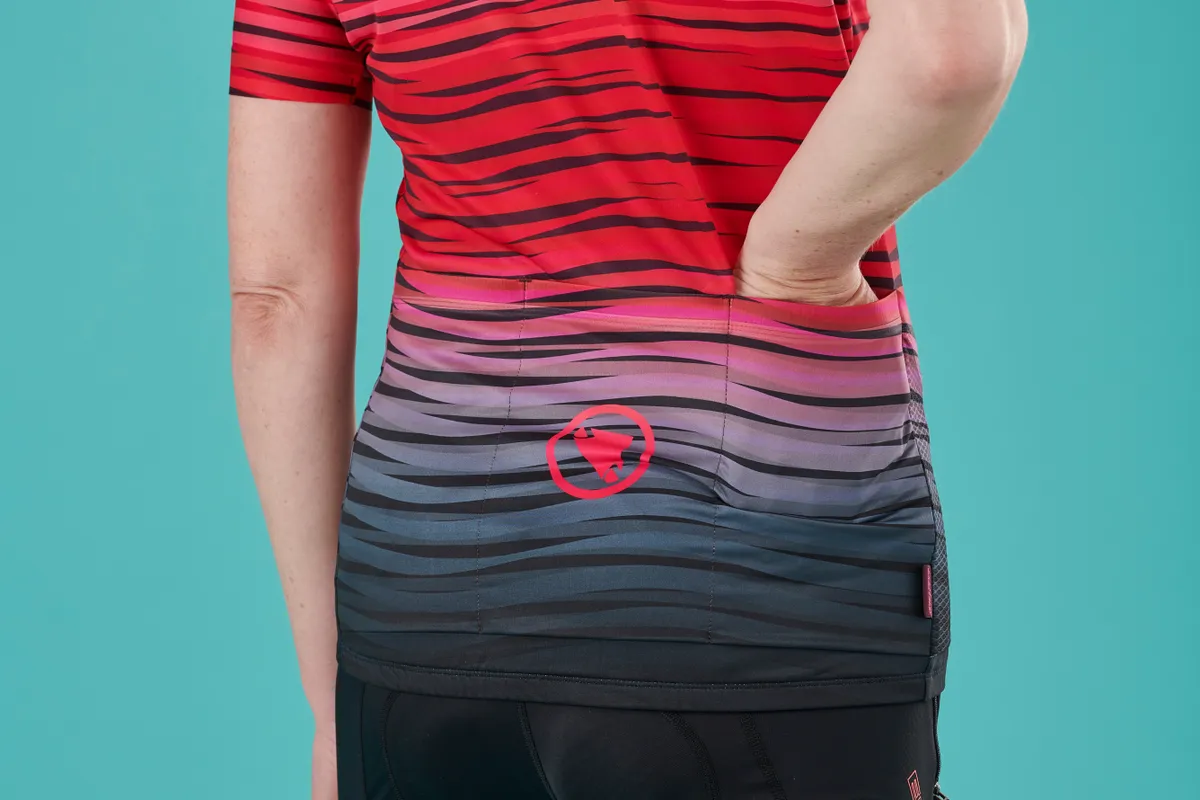
If you’re lucky and don’t have to carry too much kit with you, it’s possible that it might all fit into your pockets. The best cycling jerseys typically come with three rear pockets and you can fit a surprising amount in there.
Stuff too much in, however, and your pockets can bounce around when you get out of the saddle to tackle a climb. They may also droop to one side on a looser fitting jersey.
Lots of cycling kit is now available with extra pockets. Zips are useful to stop things falling out (particularly loose change or keys) and you can get Lycra shorts with pockets in the legs, as well as baggies with even more pockets in them.
Some clothing has lots of stowage built in and is styled to not look out of place in a casual work environment.
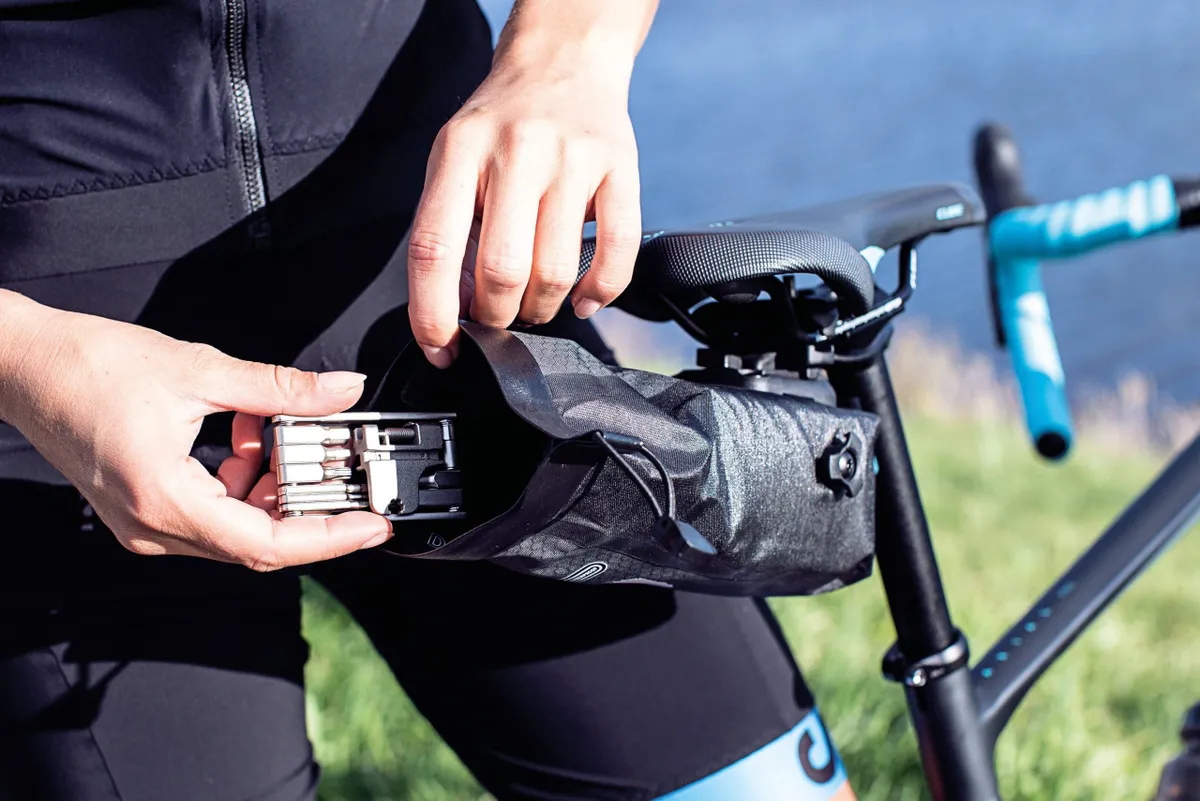
But you’re soon likely to run out of space if you’re carrying anything more than the basics. A small saddle pack like Ortlieb’s Micro Two can add up to 0.8 litres of capacity for extra gear (such as roadside tools) without ruining the aesthetics of a pared down racing machine or needing to wear a bag.
A musette (a thin fabric or plastic bag with a single strap to put over your shoulder) is another option and can be pushed round to sit on your back as you ride. They’re used by the pros for their lunch during a race, but can also add a bit of capacity for papers or other kit if you want to travel light on the commute.
Whether you’re relying on the pockets of your cycling gear, or adding a saddlebag or musette, you’re only going to be able to carry the essentials.
If you need to get changed at work, chances are you’ll need that gear in the office already. Otherwise, you’ll need more capacity…
Pros
- Easy option
- Works with any bike
- Nothing to remove from the bike when you stop
Cons
- Limited capacity
- Pockets can droop to one side or bounce if overfilled
- Not weatherproof
A backpack
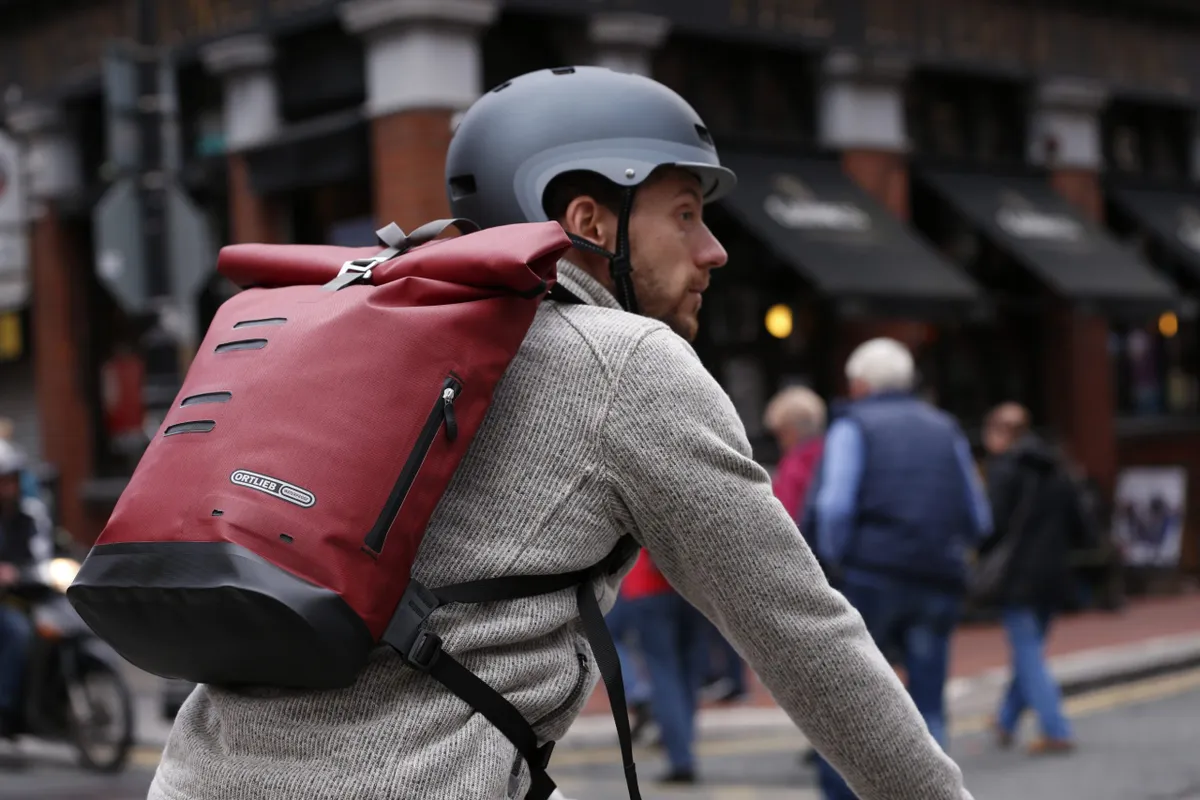
If you need more carrying power, a backpack might work for you. There are lots of options, with cycling-specific backpacks offering plenty of capacity and stability.
Many cycling packs are lightweight, waterproof and feature a roll top for easy opening. Your back is likely to get warm as you ride, so they will usually have ventilation channels or a mesh back, paired with mesh straps to help stop you getting sweaty over your shoulders.
Stability is important when riding, so there will often be a waist strap and another one across the chest to help hold the pack in place.
You may get extra pockets for smaller items, as well as a padded sleeve for a laptop. There may also be straps for a helmet or a lock, and loops to clip lights to, as well as reflective areas to further up your low light presence. Many packs, such as the Ortlieb Velocity, come in multiple colour options too, or in patterned fabrics.
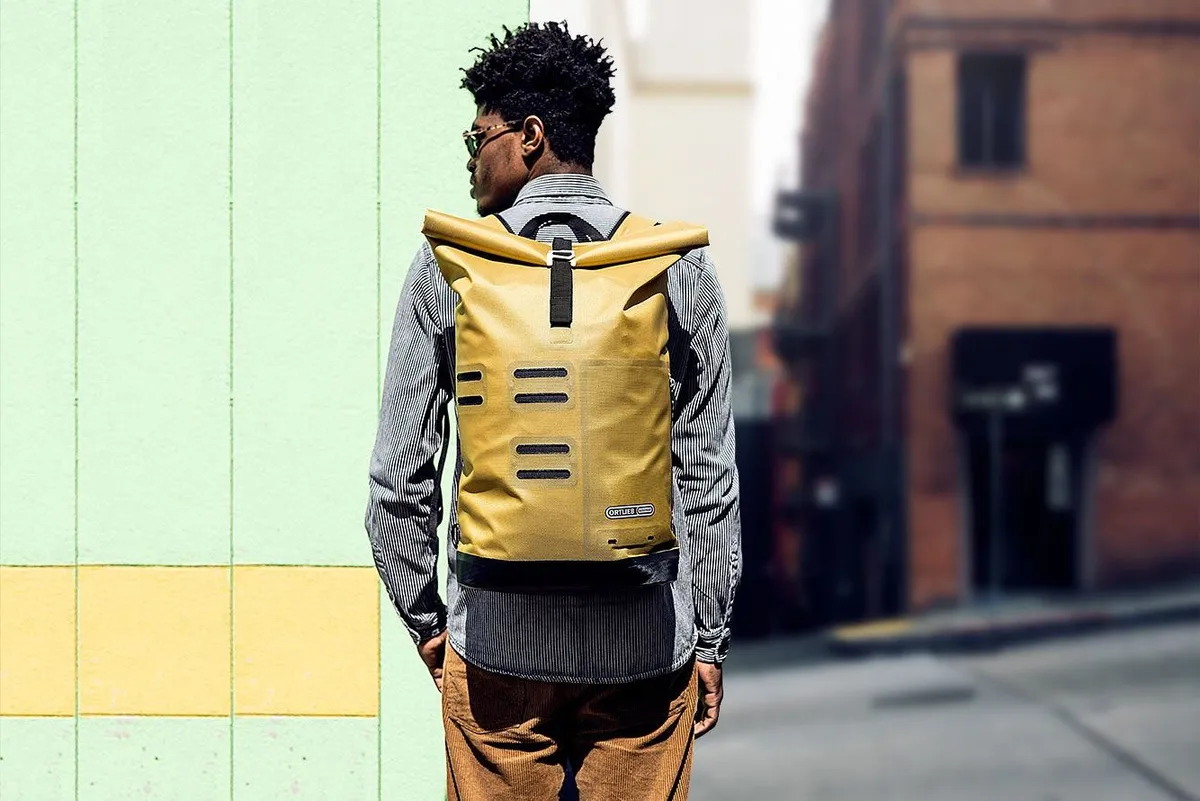
Ortlieb’s Commuter-Daypack City, meanwhile, is geared to the needs of the office worker. Bags with outdoor lifestyle design cues won’t look out of place off the bike either.
On the down side, a backpack can quickly get tiring on your shoulders if you’re riding for a longer time and it may limit your rearward view.
Also, backpacks can still get quite sweaty, particularly if riding hard or in warm weather. despite any features built in to improve breathability.
Plus, carrying extra weight on your back raises your centre of gravity, so you might feel less stable on your bike.
Pros
- Weatherproof designs available
- Plenty of capacity and pockets
- Nothing to remove from the bike when you stop
- Can be used as a daypack too
Cons
- Extra weight on your shoulders
- May limit your rearward view
- Raises your centre of gravity and lowers your stability
- Can make your back and shoulders sweaty
Messenger bag
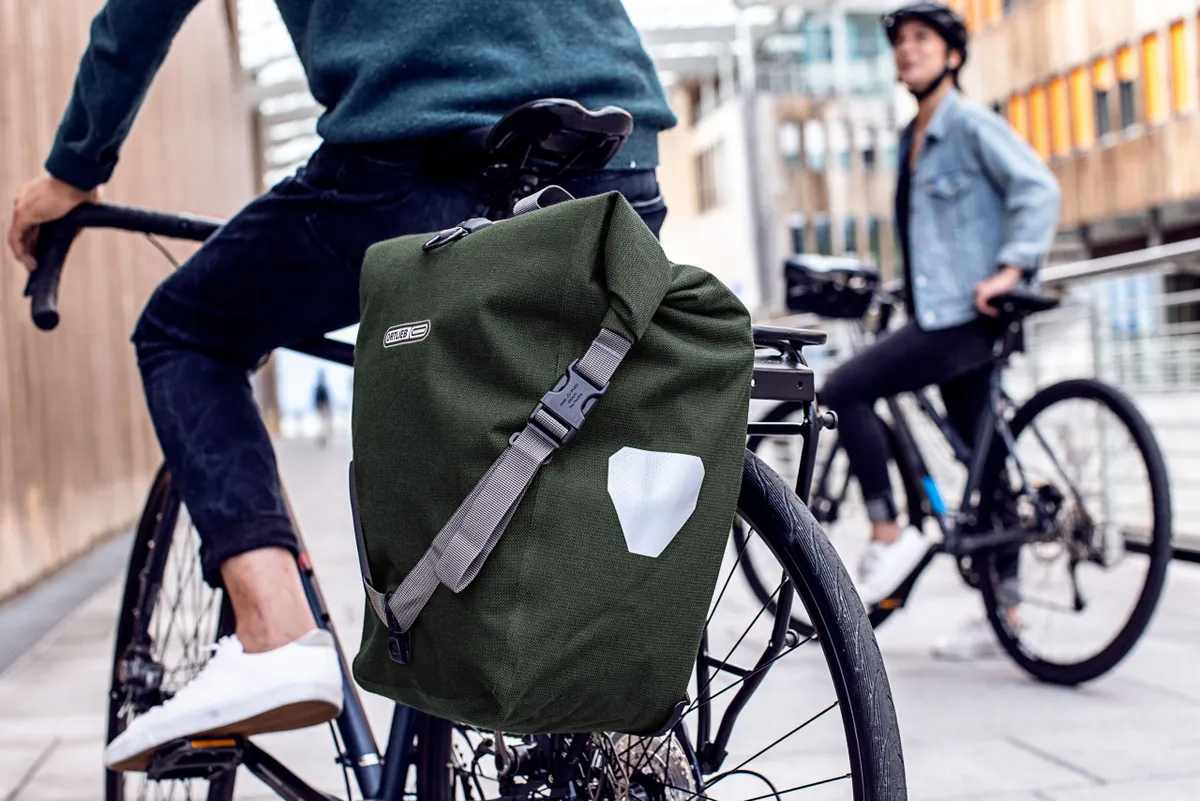
A messenger bag is another option for smaller loads. Used originally by bike couriers, many messenger bags sling over one shoulder, letting you get items in and out quickly.
You can push the bag round so that it rests on your back as you ride, but a classic messenger bag will be less stable than a backpack and can slip to your side, so it’s harder to ride with. All its weight is resting on one shoulder and getting sweaty can be an issue.
Messenger bags work best with flatter loads, like the bike couriers’ documents, but there’s not normally as much carrying capacity as with a backpack.
Pros
- Gives you the cool fixie-riding urban rider look
- Easy to load and unload
- Good for flat items such as documents
Cons
- Not as stable as a backpack
- May slip round to the side as you ride
- All the weight is on one shoulder in classic designs
- Limited capacity
Bikepacking bags
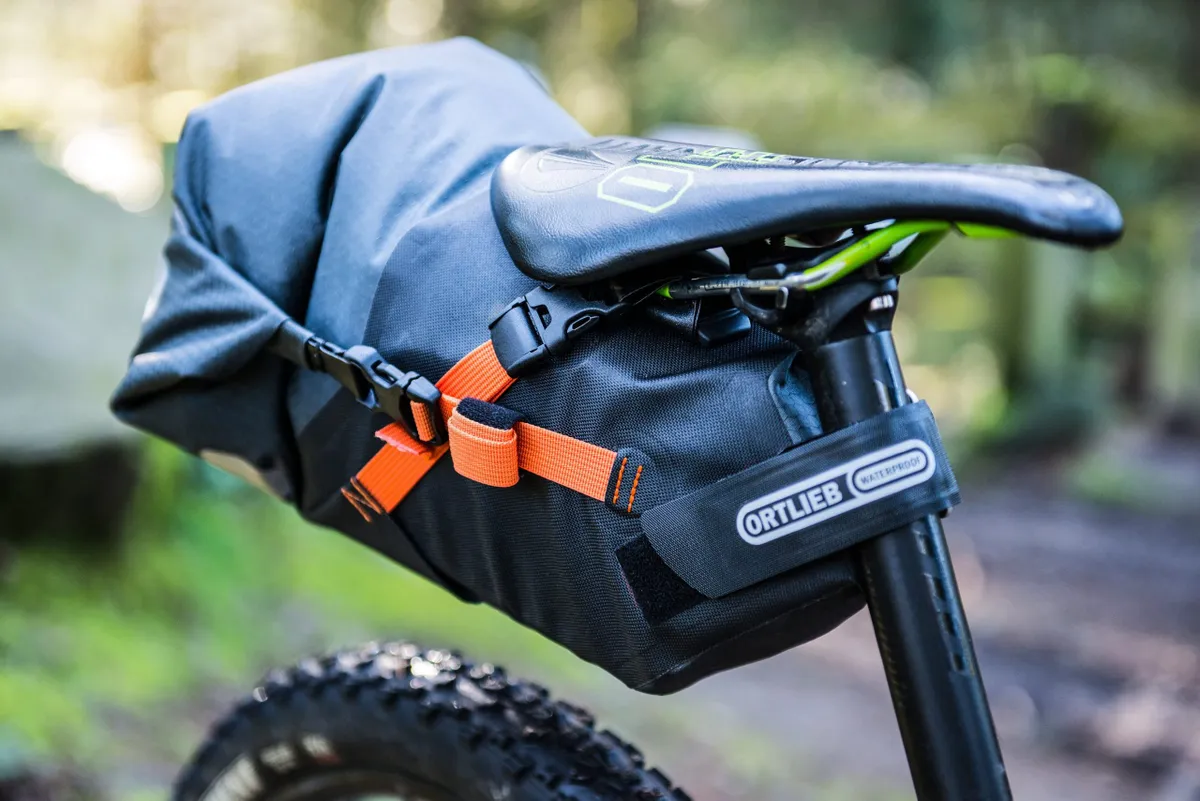
Bikepacking bags were originally designed for riders on multi-day adventures off the beaten track. However, bikepacking bags come in all different shapes and sizes, with lots of mounting and capacity options, so they can work for the commuter, too.
A big advantage of bikepacking bags is that they can be fitted to just about any bike, whether or not it has specific mounting points on its frame.
The core of a bikepacking setup is a seat pack. Looking like an enormous saddle pack, it extends way beyond the back of your saddle, offering loads of capacity – up to 16.5 litres for Ortlieb’s Seat-Pack model.
The seat pack is held in place by a series of straps that fix it to the bike’s seatpost and the saddle rails, with Velcro straps and adjusters to make sure it’s held in place firmly. Most seat packs come in a range of sizes, so you can tailor it to your needs.
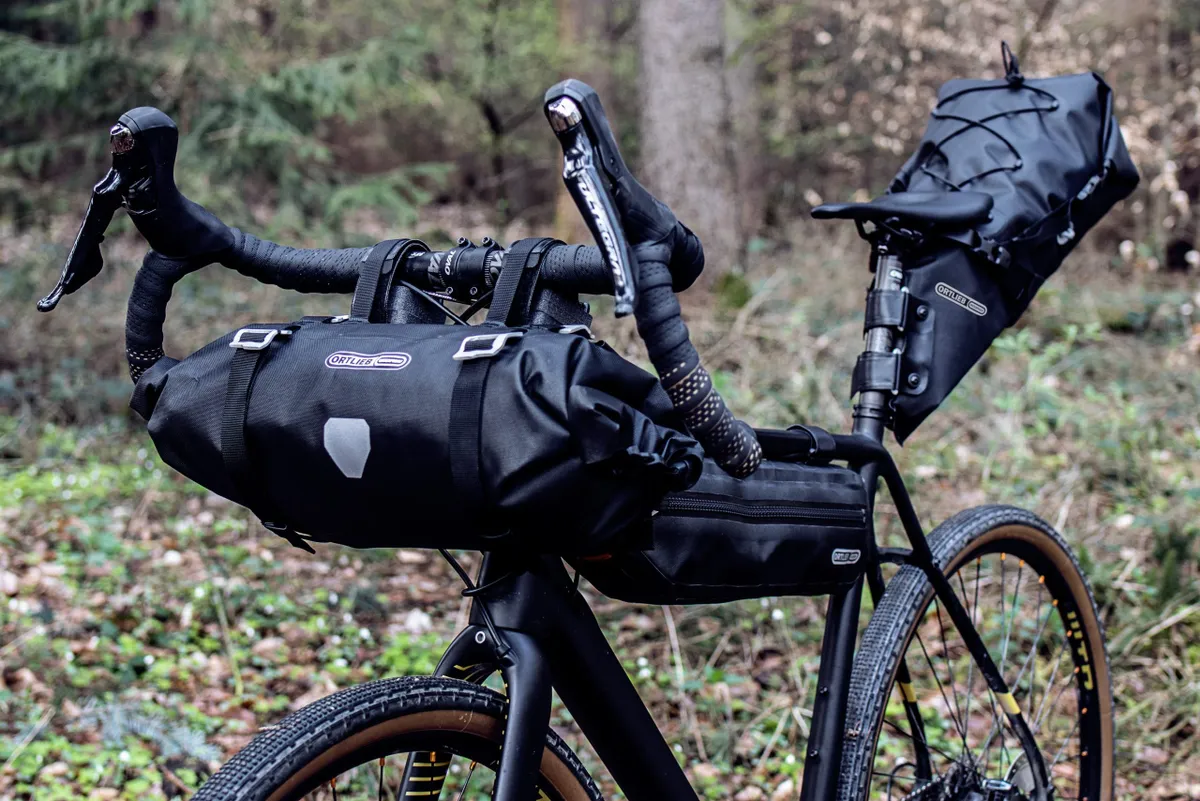
If you need more carrying capacity, you can supplement a seat pack with a handlebar bag, such as the Ortlieb Handlebar-Pack, and a frame pack like the Frame-Pack Toptube that lashes into the central space in the frame’s triangle.
Need even more? You can also get bikepacking bags that sit on the top of the top tube.
Bikepacking bags are generally designed to be weatherproof and rugged, with roll tops and waterproof zips, while the clips and straps are designed to make them easy to remove from the bike.
On the flip side, getting bikepacking bags securely fastened to your bike can be a bit fiddly because you need to get the straps well tightened to make sure that they don’t sway as you ride. The straps can also damage the finish on your bike’s frame and components if they rub as you ride.
Like a backpack, bikepacking bags will raise your centre of gravity too. This takes a bit of getting used to and you may find it awkward to get out of the saddle on a climb.
Bikepacking bags are also designed to carry squishy stuff such as a sleeping bag, spare clothing and a bivvy sack, so their shape probably won’t work if you need to carry office items on your commute.
Pros
- Weatherproof and rugged
- Lots of options to increase carrying capacity
- Will fit almost any bike
Cons
- Awkward shapes for office kit
- Raise centre of gravity and may sway
- May damage your bike’s finish
A basket
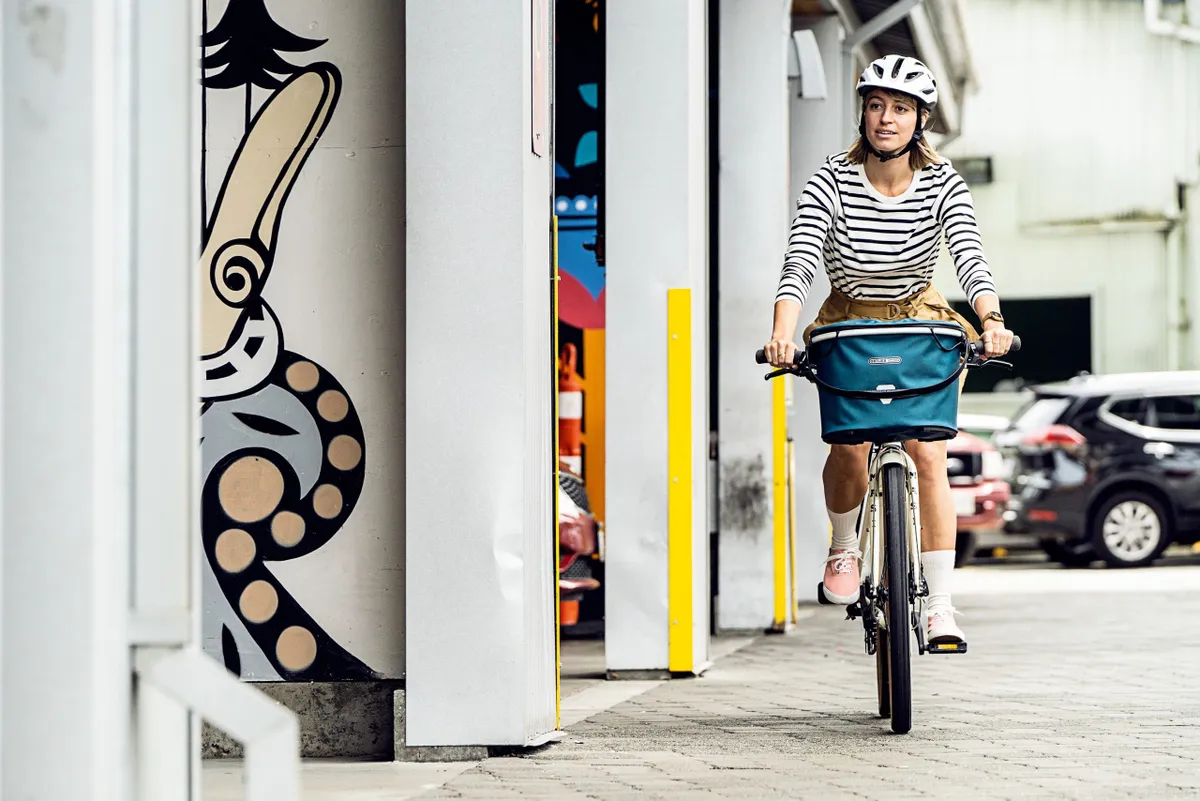
A classic upright bike would look good with a basket on its bars – traditionally woven from wicker. You can drop pretty much anything in there, from your laptop to your lunch, although since it’s not waterproof you need to watch the weather.
But there are other basket options such as the 17.5-litre Ortlieb Uptown Urban that are more practical, with waterproofing and a zip to keep your kit secure.
The Uptown is designed to be easy to take on and off your bike and comes with a carrying handle, so you can use it for shopping or to carry stuff into the office. Plus, there are patterned options for some extra style.
A basket is an option that works well for a folding bike too.
Pros
- Classic looks
- Can drop your kit in and go
- Easy fit to flat-bar bikes
Cons
- An open basket isn’t weatherproof or secure
- Limited capacity for larger items
- Extra weight on the bars may affect steering
- Best suited to upright or folding bikes only
Panniers
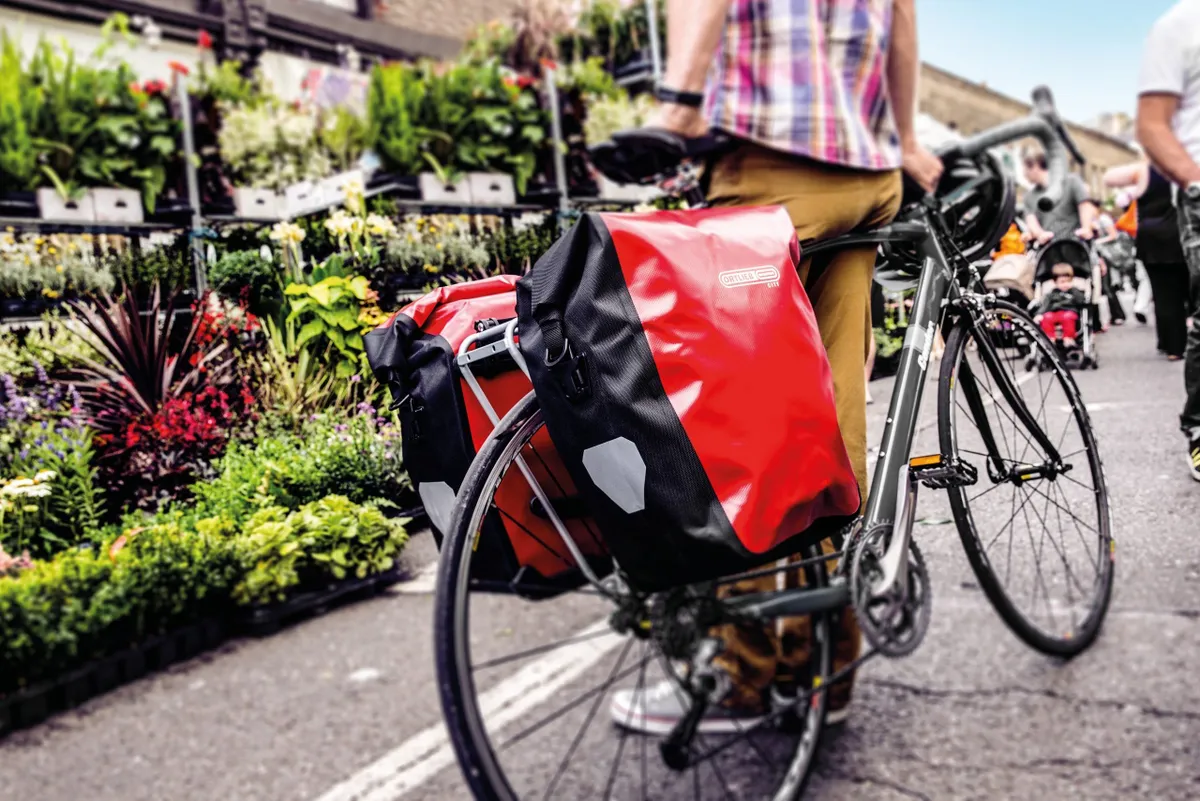
The classic solution to lugging significant loads on your bike, panniers are clipped to a metal rack bolted to the bike’s frame. The rack is usually attached to the bike’s rear triangle, but you can also get front racks that fix to the fork blades.
You’ll need a bike with mounting points to bolt a rack to. These may be specially designed for a rack, but you can also use a bike’s mudguard eyes.
So, although a rack and panniers work with many bikes, not all bike frames have the necessary fixtures. They’ll also add a significant amount of weight to your bike.
Cyclists often have a pair of panniers, but you can use just one if you’re not carrying too much – the Ortlieb Back-Roller Urban Line is sold as a single pack.
Most panniers attach to the rack with two clips at the top and another towards the bottom. These are designed to fit a range of different rack designs and have catches so that they can’t clip out accidentally or bounce off if you go over a bump.
Some panniers, such as those with Ortlieb’s QL3.1 system, utilise a slightly different system, where the mounting mechanism is left on the rack, making the back of the pannier flush and designed to be easier to carry when off the bike.
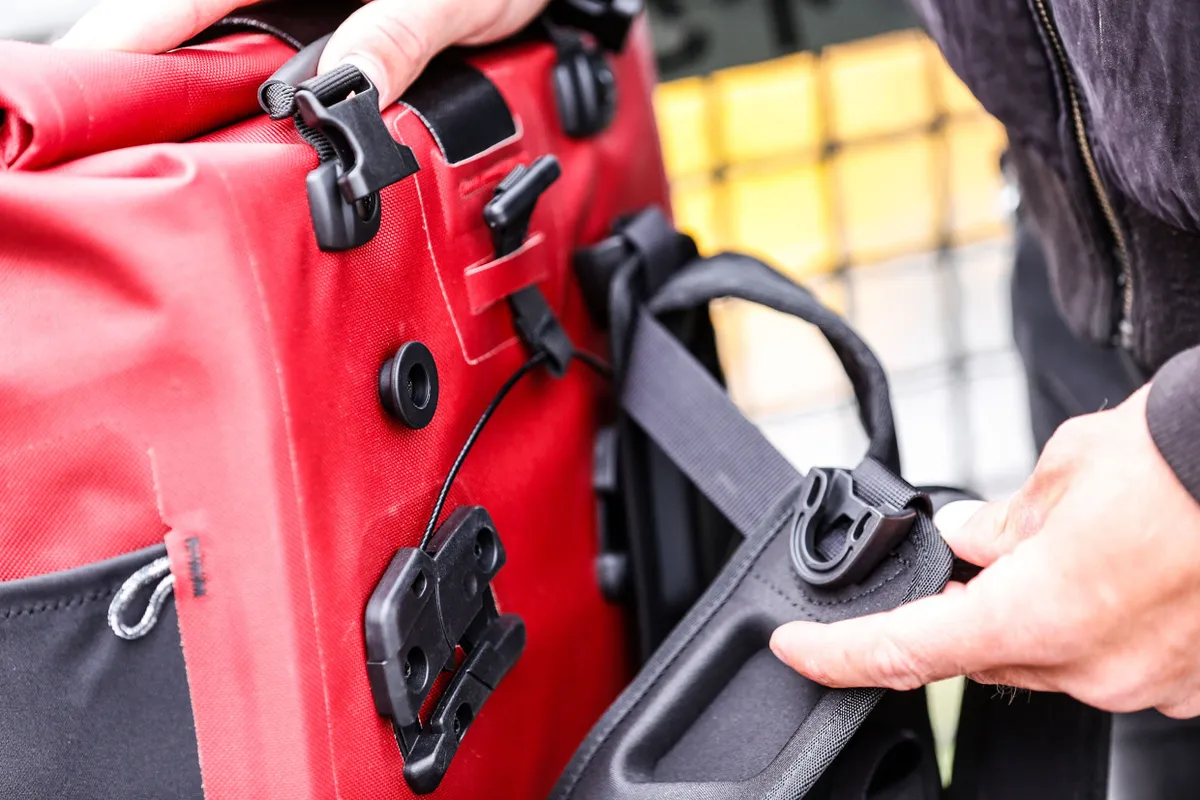
Quality panniers will usually offer a degree of water resistance because they’re likely to get sprayed by the wheels if you ride in the wet.
The best panniers on the market offer an ingress protection rating, against both water and dust, making them fully waterproof or even submersible. Roll top designs will keep the main compartment dry and there may be additional pockets with waterproof zips.
There’s usually loads of capacity – a pair of Ortlieb Back-Roller Classic panniers will take up to 40 litres. While originally designed for cycle touring, their rectangular shape is good for computers and papers. If you need more space still, there’s the option to add a bag that sits on top of the rack.
Accessories are also available to make your pannier setup more commuter-friendly. Ortlieb’s Commuter Insert is designed so you can load up the multiple compartments at home then slot it into your pannier, keeping your gear organised.

A rucksack adaptor, meanwhile, can convert a traditional pannier into a rucksack for use off the bike, while Ortlieb’s Downtown Two combines pannier clips with a classic satchel shape and a shoulder strap (like a messenger bag).
Riding low on the bike and with three points of attachment, panniers will have the least effect on your stability (apart from just using your pockets, that is). They’re easy to take on and off and often have a carrying handle or strap.
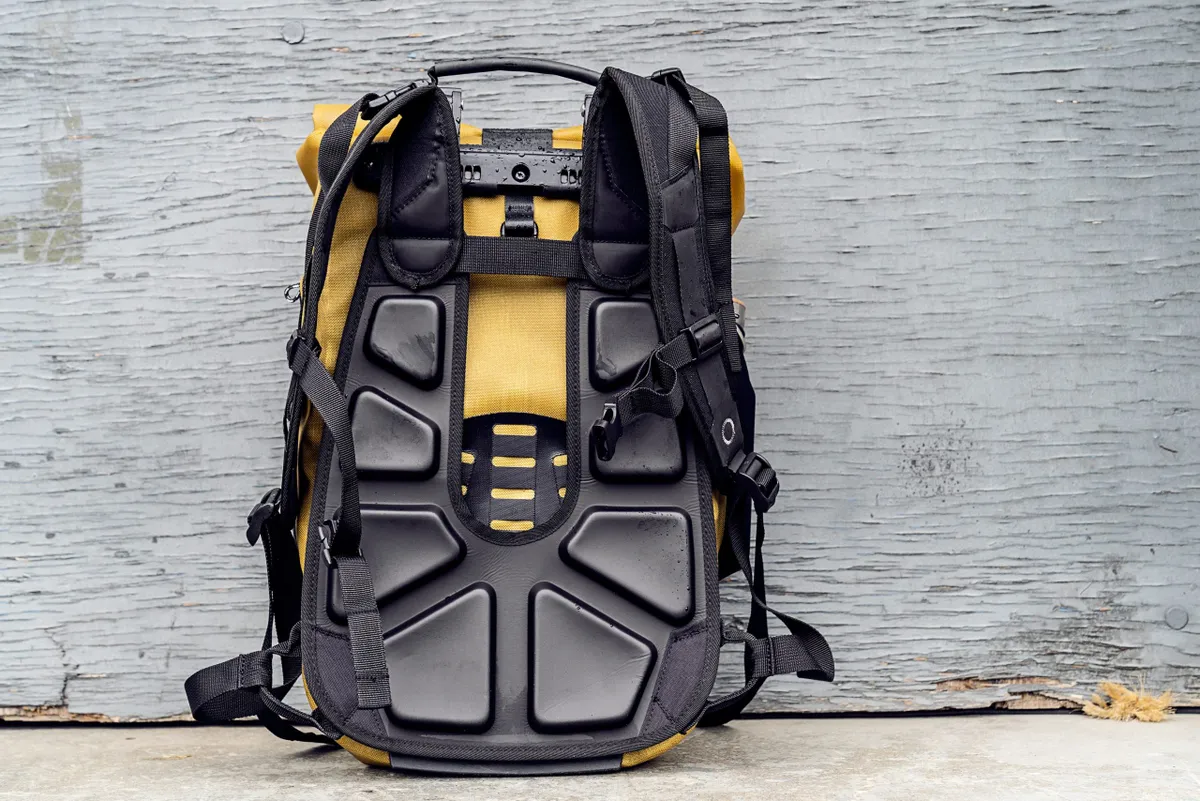
The downsides, as we’ve already mentioned, are bike compatibility and weight. The rack will also become a permanent fixture on your bike.
The Ortlieb Vario comes with shoulder straps so you can use it as a backpack too, while bags like the Downtown Two combine pannier clips with a classic satchel shape and a shoulder strap, so they look good off the bike.
Pros
- Low centre of gravity
- Lots of capacity in a shape that’s good for papers and computers
- Easy to get on and off the bike
Cons
- Bike compatibility
- Need to fit a rack to attach bags to
- The heaviest option here

